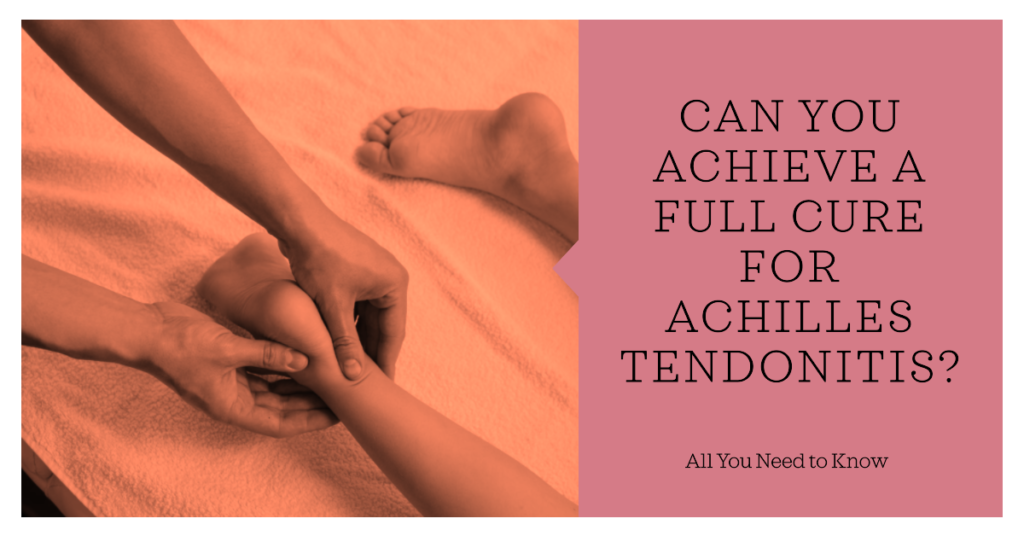Yes, Achilles tendonitis can be cured with proper treatment and rehabilitation. Achilles tendonitis is a common condition characterized by inflammation and pain in the Achilles tendon, the largest tendon in the body that connects the calf muscles to the heel bone.
It is often caused by overuse, repetitive stress, or poorly fitting footwear. The condition can be debilitating, affecting mobility and causing discomfort during daily activities. However, with the right approach to treatment, individuals can experience significant relief and a full recovery.
This article examines the various treatment options available for Achilles tendonitis, including rest, physical therapy, medications, and, in severe cases, surgery. By understanding these options, individuals can take proactive steps towards managing and ultimately overcoming Achilles tendonitis.
What Is Achilles Tendonitis?
Achilles tendonitis is characterized by inflammation and pain in the Achilles tendon. While there is no cure for Achilles tendonitis, proper rest, physical therapy, and stretching exercises can help manage the symptoms and promote healing.
Achilles tendonitis is a common condition that affects the Achilles tendon, the largest tendon in the body. This condition is characterized by inflammation and irritation of the tendon, which can cause pain and discomfort. In this section, we will explore what Achilles tendonitis is, its causes, and its associated risk factors.
Definition And Explanation Of Achilles Tendonitis
- The Achilles tendon is a muscular tissue band connecting the calf muscles to the heel bone.
- Achilles tendonitis refers to the inflammation of this tendon due to overuse or repetitive strain.
- This condition can occur in athletes and non-athletes and is often associated with repetitive jumping, running, or rapid change of direction.
Causes Of Achilles Tendonitis
- Overuse: Engaging in activities that strain the Achilles tendon excessively, such as running long distances or playing sports with frequent jumping, can lead to tendonitis.
- Lack of flexibility: A lack of flexibility in the calf muscles can put added stress on the Achilles tendon during physical activity.
- Sudden increase in activity: Abruptly increasing the intensity or duration of physical activity can overload the Achilles tendon, leading to inflammation.
- Improper footwear: Wearing shoes that do not provide adequate support or are not designed for specific activities can contribute to Achilles tendonitis.
- Poor biomechanics: Issues with foot or leg mechanics, such as flat feet or overpronation, can also increase the risk of developing this condition.
Risk Factors For Achilles Tendonitis
- Age: Tendonitis of the Achilles tendon is more common in individuals between 30 and 50.
- Gender: Males are more prone to Achilles tendonitis compared to females.
- Sports participation: Participating in sports that involve repetitive motions, such as running, tennis, or basketball, increases the risk of developing Achilles tendonitis.
- Obesity: Excess body weight stresses the Achilles tendon, making it more susceptible to inflammation.
- Certain medical conditions: Conditions like diabetes and high blood pressure can weaken tendons, increasing the likelihood of tendonitis.
Understanding what Achilles tendonitis is, its causes and associated risk factors is crucial in managing and preventing it. Individuals can effectively manage Achilles tendonitis and promote a healthy recovery by taking steps to minimize the risk factors and practicing proper self-care.
Symptoms Of Achilles Tendonitis
Achilles tendonitis symptoms, including pain, tenderness, and swelling, can be treated with rest, ice, physical therapy, and anti-inflammatory medication. With proper care, it is possible to cure Achilles tendonitis and return to normal activities.
Achilles tendonitis is a common condition characterized by inflammation and irritation of the Achilles tendon, which connects the calf muscles to the heel bone. This condition often occurs from overuse or repetitive stress on the tendon, leading to pain and discomfort.
Recognizing the symptoms of Achilles tendonitis is crucial for early diagnosis and prompt treatment. Here are the common signs and symptoms to be aware of:
- Pain and stiffness: Achilles tendonitis typically presents as pain and stiffness in the back of the leg, near the heel. The pain often worsens with physical activity, such as running or jumping, and may ease with rest.
- Tenderness and swelling: The affected area may feel tender to the touch, and swelling may be present, particularly around the Achilles tendon.
- Morning stiffness: Many individuals with Achilles tendonitis experience increased stiffness and pain in the morning, which tends to improve with movement throughout the day.
- Thickening of the tendon: In some cases, the Achilles tendon may feel thickened or have nodules along its length. This can be a sign of chronic tendonitis or degeneration.
How to identify Achilles Tendonitis:
- Perform a physical examination: A healthcare professional will assess your ankle and lower leg, looking for swelling, tenderness, or thickening along the Achilles tendon. They may also check your range of motion and muscle strength.
- Evaluate medical history: It is essential to inform your healthcare provider about your symptoms when they started and any activities or sports that may have contributed to the condition.
- Diagnostic tests: In some cases, imaging tests such as ultrasound or MRI may be ordered to confirm the diagnosis and evaluate the extent of the tendon damage.
When to seek medical help:
- Persistent or worsening pain: If you experience ongoing or worsening pain in your Achilles tendon, despite home remedies and conservative treatments, it is advisable to seek medical attention.
- Difficulty walking or bearing weight: If your Achilles tendon pain makes walking or carrying weight on the affected leg challenging, it is crucial to consult a healthcare professional.
- Signs of severe rupture: If you hear a sudden “pop” in your Achilles tendon followed by significant pain, or if there is a visible gap or bulge above the heel, seek immediate medical attention, as these may indicate a severe tendon rupture.
Early recognition and appropriate Achilles tendonitis treatment can help alleviate symptoms and prevent further complications.
Rest And Immobilization
Rest and immobilization are crucial for curing Achilles tendonitis. The body can effectively repair itself and reduce inflammation by giving the tendon time to heal and limiting movement. Effective treatment often involves using a cast, boot, or brace to immobilize the affected area.
Can Achilles Tendonitis Be Cured?
Dealing with Achilles tendonitis can be painful and frustrating. This common condition occurs when the Achilles tendon, which connects the calf muscles to the heel bone, becomes inflamed. If you’re wondering if Achilles tendonitis can be cured, rest and immobilization play a vital role in healing.
Importance Of Rest In The Healing Process
Rest is crucial when it comes to treating Achilles tendonitis. Allowing the affected tendon time to recover and repair can significantly speed up the healing process. Here are a few reasons why rest is so important:
- Reduction of inflammation: Resting the affected tendon helps reduce inflammation, a significant contributor to Achilles tendonitis. Giving your tendon a break gives it a chance to calm down and heal.
- Prevention of further damage: Continuing to strain an injured tendon can worsen the condition and lead to more severe symptoms. Resting allows your tendon to heal without the risk of further damage.
- Tissue recovery: Resting allows your body to regenerate and repair damaged tissues in the tendon. This is essential for a complete recovery.
Immobilization Techniques And Devices
In some cases, immobilizing the affected area can provide additional support and aid in healing. Here are a few techniques and devices commonly used for immobilization:
- Braces or splints: These devices provide stability and restrict movement, allowing the tendon to rest and heal.
- Compression wraps: Wrapping the affected area with a compression bandage can help reduce swelling and provide support.
- Crutches: If your tendonitis is severe, crutches may be necessary to avoid putting weight on the affected leg and give the tendon time to heal.
How Long To Rest And Immobilize For Optimal Recovery
The duration of rest and immobilization can vary depending on the severity of your Achilles tendonitis. However, giving your tendon enough time to heal correctly is important. Here are some general guidelines to consider:
- Mild cases: Resting and immobilizing for 1-2 weeks may be sufficient to alleviate symptoms and promote healing.
- Moderate cases: It is recommended to rest and immobilize for 3-4 weeks, allowing for more significant healing and reduced inflammation.
- Severe cases: If your Achilles tendonitis is severe, it may be necessary to rest and immobilize for 6-8 weeks or even longer. This prolonged period is vital for a complete recovery.
Remember, it’s crucial to consult with a healthcare professional to determine the appropriate rest and immobilization period based on your specific condition.
Rest and immobilization are vital aspects of curing Achilles tendonitis. Giving your tendon the time and support it needs can promote healing, reduce inflammation, and facilitate a successful recovery. Remember to listen to your body and seek medical advice for optimal treatment.
Physical Therapy And Stretching Exercises
Achilles tendonitis can be effectively treated through physical therapy and stretching exercises, relieving pain and improving mobility. With the right approach, patients can fully recover and return to their regular activities.
Role Of Physical Therapy In Treating Achilles Tendonitis
Physical therapy is vital in treating Achilles tendonitis as it focuses on reducing pain, promoting healing, and restoring mobility. Here are some critical aspects of how physical therapy can help:
- Assessment and diagnosis: A physical therapist will evaluate the severity of your Achilles tendonitis, identify any contributing factors, and develop a personalized treatment plan.
- Pain management: Through various techniques like soft tissue mobilization, ultrasound, or electrical stimulation, physical therapists can effectively alleviate pain and inflammation in the affected area.
- Strengthening exercises: Specific exercises targeting the muscles and tendons around the Achilles will be prescribed to improve strength, stability, and flexibility. These may include eccentric exercises, calf raises, or resistance training.
- Gait analysis: Physical therapists analyze your walking or running technique to identify any gait abnormalities that may contribute to Achilles tendonitis. Correcting these issues can reduce strain on the tendon and promote healing.
- Education and self-management: Physical therapists provide invaluable guidance on proper footwear, activity modifications, and home exercises to optimize your recovery and prevent future injuries.
Specific Stretching Exercises For Achilles Tendonitis
Incorporating targeted stretching exercises into your treatment plan can significantly aid in the healing process of Achilles tendonitis. Here are a few recommended stretches:
- Calf stretch: Stand facing a wall with your hands on it at shoulder height. Step one foot back, keeping both feet flat on the ground. Lean forward, bending your front knee while keeping your back leg straight. Hold for 30 seconds and repeat on each leg.
- Plantar fascia stretch: Sit with one leg extended and the other foot resting on your knee. Gently pull the toes of the extended leg toward you until you feel a stretch along the bottom of your foot. Hold for 30 seconds and repeat on the other side.
- Heel drop stretch: Stand on a step with your heels hanging off the edge. Slowly lower your heels until you feel a time in your calves. Hold for 30 seconds and repeat several times.
- Eccentric calf exercise: Stand on the edge of a step with your heels off the edge. Rise on both toes, then slowly lower your unaffected foot until your heel drops below the stage. Push up again with both feet and repeat for 10-15 repetitions.
Benefits And Precautions Of Physical Therapy
Physical therapy offers several benefits when it comes to treating Achilles tendonitis. Here’s what you need to know:
- Improved healing: Physical therapy helps stimulate blood flow to the injured area, promoting tissue repair and accelerating healing.
- Pain reduction: Through various modalities and techniques, physical therapy can effectively reduce pain and inflammation associated with Achilles tendonitis.
- Restored function: By targeting the underlying causes of Achilles tendonitis, physical therapy helps restore mobility, strength, and flexibility, allowing you to return to normal activities.
However, it’s essential to keep a few precautions in mind while undergoing physical therapy for Achilles tendonitis:
- Avoid overexertion: Follow the guidance of your physical therapist and avoid pushing yourself too hard during exercises, as this could aggravate the condition.
- Gradual progression: Begin with gentle stretching and gradually increase intensity and duration as your symptoms improve. Avoid jumping into high-impact activities without proper guidance.
- Consistency: Regularly attend physical therapy sessions and diligently perform the prescribed exercises at home to achieve optimal results.
Remember, physical therapy should be tailored to your specific condition and implemented under the guidance of a qualified professional. It is advisable to consult with a healthcare provider before initiating any treatment regimen.
Medications And Injections
Achilles tendonitis can be treated with a combination of medications and injections, which help to reduce pain and inflammation in the affected area. These treatments aim to alleviate the symptoms and promote healing, allowing individuals to regain mobility and function.
Medications Commonly Used To Manage Pain And Inflammation
- Nonsteroidal anti-inflammatory drugs (NSAIDs): These medications, such as ibuprofen and naproxen, are often used to reduce pain and inflammation associated with Achilles tendonitis.
- Topical creams and ointments: Certain creams and lotions containing NSAIDs or other pain-relieving ingredients can be applied directly to the affected area for targeted relief.
- Pain relievers: Over-the-counter analgesics like acetaminophen may temporarily relieve Achilles tendonitis pain, although they do not specifically target inflammation.
Corticosteroid Injections And Their Effectiveness
- Corticosteroid injections: These injections deliver powerful anti-inflammatory medication directly to the site of Achilles tendonitis. They can provide significant pain relief and reduce inflammation.
- Speed of relief: Corticosteroid injections can provide quick relief, often within a few days of administration.
- Long-term effectiveness: While corticosteroid injections can offer temporary relief, their long-term point is still under debate. Some studies suggest repeated injections may lead to tendon weakening or increased risk of tendon rupture.
Potential Risks And Side Effects Of Medications And Injections
- Gastrointestinal issues: NSAIDs can cause stomach irritation, ulcers, and bleeding when taken in high doses or over a prolonged period.
- Kidney and liver problems: Long-term use of NSAIDs may affect kidney and liver function.
- Allergic reactions: Some individuals may experience allergic reactions to certain medications. Seek immediate medical attention if you develop difficulty breathing or swelling symptoms.
- Tendon damage: Corticosteroid injections, while providing short-term relief, can potentially weaken the tendon if used excessively or improperly. This may increase the risk of tendon rupture.
Medications and injections are commonly used to manage pain and inflammation associated with Achilles tendonitis. Nonsteroidal anti-inflammatory drugs, topical creams, and ointments can provide relief, while corticosteroid injections can offer more immediate and targeted relief. However, there are potential risks and side effects associated with these treatments, including gastrointestinal issues, kidney and liver problems, allergic reactions, and tendon damage.
It is crucial to consult a healthcare professional to assess the benefits and risks of these treatments in each case.
Orthotics And Footwear Modifications
Orthotics and footwear modifications can help alleviate the symptoms of Achilles tendonitis, but a complete cure may not be possible. These interventions can support and reduce stress on the affected tendon, promoting healing and improving overall foot function. However, it’s essential to consult with a healthcare professional for a personalized approach to treatment.
: Finding Relief For Achilles Tendonitis
The Use Of Orthotic Devices For Achilles Tendonitis:
- Orthotic devices, such as shoe inserts or custom-made supports, can provide much-needed relief for individuals suffering from Achilles Tendonitis.
- These devices are designed to help reduce stress on the Achilles tendon and provide support and stability to the foot and ankle.
- Orthotics can help to correct biomechanical issues, such as overpronation or flat feet, which can contribute to Achilles Tendonitis.
- By redistributing pressure and aligning the foot correctly, orthotic devices can help alleviate pain and aid in healing.
Choosing Appropriate Footwear For Prevention And Support:
- The proper footwear plays a vital role in managing and preventing Achilles Tendonitis.
- Look for shoes that provide adequate cushioning and support for the arch, heel, and Achilles tendon.
- Opt for shoes with a firm heel counter, which helps to stabilize the foot and prevent excessive movement.
- Shoes with a slightly raised heel, known as a heel lift, can help to reduce stress on the Achilles tendon.
- Avoid high heels, which can strain the Achilles tendon and exacerbate existing issues.
- Choose shoes with a wide toe box to allow ample toe room and prevent constriction.
Tips For Selecting And Using Orthotics And Footwear:
- Consult with a podiatrist or orthopedic specialist to determine the most suitable orthotic device for your needs.
- Ensure your orthotics are correctly fitted and adjusted for maximum comfort and support.
- Gradually introduce orthotics into your footwear routine to allow your feet to adapt to the changes.
- Replace worn-out or damaged orthotics to ensure continued effectiveness.
- When selecting footwear, try them on and walk around to assess comfort and fit.
- Consider rotating between multiple pairs of shoes to prevent excessive wear and tear on one team.
- Regularly check your shoes for signs of wear and tear, and replace them if necessary.
- If your Achilles tendonitis persists or worsens, consult a healthcare professional for further examination and treatment options.
Individuals with Achilles tendonitis can find relief and support for their condition by incorporating orthotic devices and choosing appropriate footwear. Remember to consult a healthcare professional to ensure you use the most proper orthotics and footwear for your specific needs.
Strengthening And Conditioning Exercises
Strengthening and conditioning exercises can help manage Achilles tendonitis, but a complete cure depends on the severity of the condition. It is essential to consult a healthcare professional for a comprehensive treatment plan that may include exercises, rest, and other interventions.
Chronic pain in the Achilles tendon can be frustrating and significantly impact your daily activities. However, the good news is that Achilles tendonitis can be effectively managed and even cured with the right approach. Strengthening and conditioning exercises play a crucial role in this process, helping alleviate pain and prevent future flare-ups.
This section will discuss the importance of strengthening the calf muscles, recommended exercises for conditioning the Achilles tendon, and how to incorporate exercise into a long-term maintenance plan.
Importance Of Strengthening The Calf Muscles:
- Building strength in the calf muscles can help support and protect the vulnerable Achilles tendon.
- Strengthening exercises can improve the overall stability of the ankle and reduce the strain on the tendon during physical activities.
- Strong calf muscles can enhance your athletic performance and minimize the risk of future injuries.
Recommended Exercises For Conditioning The Achilles Tendon:
- Calf raises: Stand with your feet hip-width apart, then rise onto your toes, lifting your heels as high as possible. Lower back down and repeat for several reps.
- Eccentric calf drops: Stand on the edge of a step with your heels hanging off. Rise onto your toes and slowly lower your heels below the step’s surface. Repeat this falling movement in a controlled manner.
- Ankle dorsiflexion stretch: Sit on the floor with your legs extended in front of you. Use a towel or resistance band to gently pull your toes towards you, stretching your calf muscles.
Incorporating Exercise Into A Long-Term Maintenance Plan:
- Start slowly and gradually increase the intensity and duration of your exercises over time.
- Listen to your body and stop if you experience pain or discomfort during the exercises.
- Combine these exercises with other forms of low-impact cardiovascular exercise, such as swimming or cycling, to maintain overall fitness without excessive strain on the Achilles tendon.
- Consistency is key – aim for regular exercise sessions to ensure the long-term benefits of strengthening and conditioning.
By incorporating these strengthening and conditioning exercises into your routine, you can effectively address Achilles tendonitis and work towards healing and preventing future pain. Before starting any new exercise program, remember to consult with a healthcare professional or qualified trainer to ensure it suits your specific condition.
Stay committed, be patient, and enjoy the journey towards a healthier Achilles tendon.
Surgical Options
Achilles tendonitis can be effectively treated through various surgical options, offering long-term relief and improved functionality. These options include procedures such as debridement, repair, or even a tendon transfer, depending on the severity of the condition and the patient’s specific needs.
Patients can find lasting solutions to their Achilles tendonitis woes through these surgical interventions.
When Surgery Is Considered For Achilles Tendonitis
- Severe cases of Achilles tendonitis where non-surgical treatments have failed may require surgical intervention.
- Surgery is typically considered when the pain and inflammation in the Achilles tendon persist despite conservative treatments.
- The decision to undergo surgery is usually made in consultation with a medical professional specializing in orthopedics.
- Surgery may be recommended if the Achilles tendon is severely damaged or if there is a rupture.
Different Surgical Procedures And Their Goals
- Several surgical options are available for the treatment of Achilles tendonitis, each with its own goals and benefits. These include:
- Debridement: This procedure involves removing damaged or scar tissue from the Achilles tendon to promote healing and reduce pain.
- Tendon transfer: In cases where the Achilles tendon is severely damaged, a nearby tendon may replace the damaged tendon and restore function.
- Lengthening: In some cases, the Achilles tendon may be surgically lengthened to relieve tension on the tendon and reduce strain.
- Open surgery may be necessary for repairing a completely ruptured Achilles tendon. The ends of the tendon are sutured back together to allow for healing.
Recovery And Rehabilitation After Surgery
- After Achilles tendonitis surgery, following a specific recovery and rehabilitation plan is important to ensure a successful outcome. This typically involves:
- Immobilization: Initially, the foot and ankle may be immobilized using a cast or walking boot to protect the surgical site and promote healing.
- Physical therapy: Physical therapy plays a crucial role in the recovery process. It helps to regain strength, flexibility, and range of motion in the affected leg.
- Gradual return to activity: It is important to gradually increase activity levels under the guidance of a healthcare professional to prevent reinjury and ensure a full recovery.
- Patient education: Patients are provided with instructions on how to care for the surgical site, manage pain, and prevent complications.
Remember that every case of Achilles tendonitis is unique, and the decision to undergo surgery should be made in consultation with a healthcare professional. Rehabilitation is a crucial part of the recovery process to help regain strength and function in the affected leg.
Frequently Asked Questions For Can Achilles Tendonitis Be Cured
Does Achilles Tendonitis Ever Fully Heal?
Achilles tendonitis can fully heal with the proper treatment, rest, and rehabilitation exercises.
Can Achilles Tendonitis Be Permanent?
Yes, Achilles tendonitis can become permanent if not treated promptly and appropriately.
Is It OK to Walk With Achilles Tendonitis?
Yes, it is generally safe to walk with Achilles tendonitis as long as you do so with caution.
Is Tendonitis A Permanent Condition?
Tendonitis is not typically permanent, but it may take time to heal with proper treatment.
Conclusion
Curing Achilles tendonitis with the proper treatment and rehabilitation protocols is possible. Individuals can heal their injured Achilles tendons and regain their mobility by following a comprehensive approach that includes rest, ice, pain management, and physical therapy exercises.
It is crucial to address the underlying causes of Achilles tendonitis, such as overuse or improper footwear, to prevent future occurrences. Moreover, incorporating stretching and strengthening exercises into one’s routine can help maintain the health and flexibility of the Achilles tendon, reducing the risk of reinjury.
Remember, listening to your body and seeking professional guidance is essential throughout recovery. By following these steps and committing to a well-rounded treatment plan, it is possible to fully recover from Achilles tendonitis and return to an active, pain-free lifestyle.






